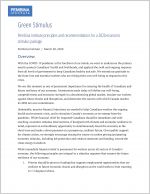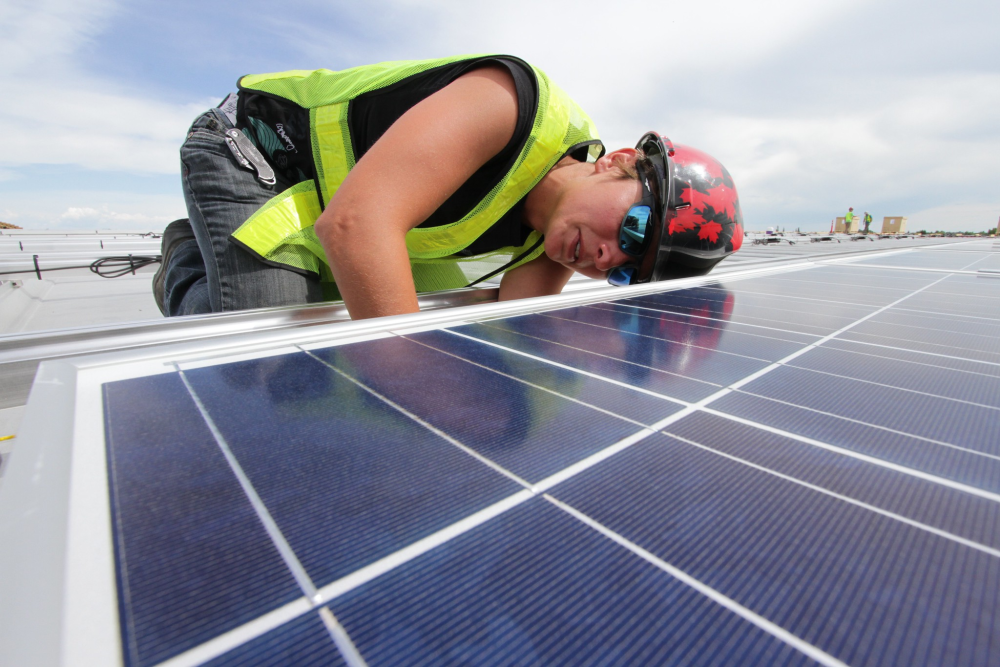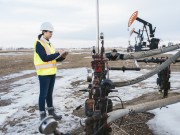As frontline and essential workers put their lives at risk to respond to the COVID-19 crisis, and as financial relief measures are being enacted to help Canadian workers deal with the economic fallout, others are starting to do the necessary thinking about how we will rebuild Canada’s economy when we finally manage to flatten the curve. There’s no playbook to draw from, no textbook to refer to. No one knows with any degree of certainty when, and in what state, we will emerge.
But we do know this: It would be a mistake to solve one crisis by exacerbating another. As we think about how to rebuild our economy, we can’t choose to ignore the other planetary health problem we have to address. The threat of climate change only grows the longer we put off treating it. Already, Canada is warming at twice the global rate, and climate change is costing Canadians billions of dollars a year.
Investment choices supported by strong climate policy
[subscribe:moo,align=right]Undeniably, massive financial injections are needed to help Canadians weather the ongoing health and economic crisis. While financial relief for impacted workers, businesses and communities should be immediate and insulate them from shocks to services, investment choices we make to rebuild Canada’s economy as we emerge from the pandemic should be grounded in and supported by strong climate policy, and designed in alignment with climate, health and economic goals. To ensure success in a decarbonizing global marketplace in the years to come, the following principles should be integral to our stimulus response:
- Following immediate financial relief, the priority for stimulus measures should be given to funding that supports employment opportunities that will withstand future economic shocks and disruption as the world seeks to limit warming to 1.5 degrees Celsius.
- Investments that support the development of industries and businesses producing low- and zero-carbon goods and services should be prioritized to grow the foundation for Canada’s low-carbon economy and secure our domestic supply chain.
- Investments in industry should incentivize decarbonization efforts that go beyond existing regulatory requirements.
- And, finally, where possible, economic recovery decisions should be made through the lens of Canada’s ability to meet its climate commitments.
This means, among other things, investing in Canadian workers.
Retraining in vital sectors
Along with immediate financial relief, Canada would do well to invest in retraining for building professionals, contractors and trades to design and construct high-performance buildings and retrofit existing building stock. Canada’s major federal parties have promised climate action on building code and financing for deep retrofits for existing buildings. A national-in-scope retraining and rebuilding program would provide jobs now and later, in alignment with election promises and Canada’s climate goals.
Retraining for auto workers, paired with investment in manufacturing capacity, would help Canada capitalize on the zero-emission vehicle manufacturing economy, which globally is poised for dramatic growth. Without strategic investment, we will miss the chance to capture market share — and create manufacturing jobs while reducing carbon emissions. Given commitments to “green” freight in Canada, this investment, too, should benefit from all-party support.
Whether we are ready for it or not, this pandemic is forcing the conversation in Canada on how our oil and gas sector can be more resilient to shocks and disruption as the world decarbonizes to stave off the most devastating impacts of climate change. Investment must be prioritized to help meet workers’ immediate and long-term needs for sustainable employment. Priority should be given to funding to create work detecting and controlling methane emissions to make Canada’s oil and gas more competitive, and cleaning up old well sites to remove liabilities from balance sheets. Investment is needed to build expertise in clean technology, and actually implement clean technology capital investment projects that will lower carbon emissions in that sector. And, finally, funding should be directed to training workers for careers increasingly in demand in low-carbon sectors like energy efficiency and renewable energy.
Even before the pandemic, oilsands workers had been subjected to global price shocks and fewer job opportunities (despite higher oilsands production) due to increasing automation. We have an opportunity now to invest in a resilient future for our workers, rather than decades of ongoing instability in an already volatile sector.
Carbon pricing remains key
 Underpinning all of our economic rebuilding efforts is the fundamental building block in Canada’s climate plan: carbon pricing. This is, by far, the cheapest and most efficient way to reduce costly climate pollutants that are already undermining our health, ecosystems and way of life. As COVID-19 exacts the heaviest costs from those least able to afford it, this tool puts more money directly in the bank accounts of Canadian families that need it most. Given the incredible financial burden climate change is already placing on our communities (increasing wildfires, flooding, droughts, extreme storms, ocean acidification, freshwater temperature changes, vector-borne diseases, climate-change driven infestations, increased air pollution), this is not the time to cancel this most important climate prescription. This would be like eliminating social/physical distancing just as the curve is starting to rise. Stay the course.
Underpinning all of our economic rebuilding efforts is the fundamental building block in Canada’s climate plan: carbon pricing. This is, by far, the cheapest and most efficient way to reduce costly climate pollutants that are already undermining our health, ecosystems and way of life. As COVID-19 exacts the heaviest costs from those least able to afford it, this tool puts more money directly in the bank accounts of Canadian families that need it most. Given the incredible financial burden climate change is already placing on our communities (increasing wildfires, flooding, droughts, extreme storms, ocean acidification, freshwater temperature changes, vector-borne diseases, climate-change driven infestations, increased air pollution), this is not the time to cancel this most important climate prescription. This would be like eliminating social/physical distancing just as the curve is starting to rise. Stay the course.
It is inspiring to see Canadians come together to tackle this difficult global health challenge. It’s equally reassuring to witness governments across the country make science-based policy decisions. Canadians support climate action. It’s imperative we honour that support and apply the same scientific approach to rebuilding a resilient economy able to withstand — and even help ward off — future crises.










